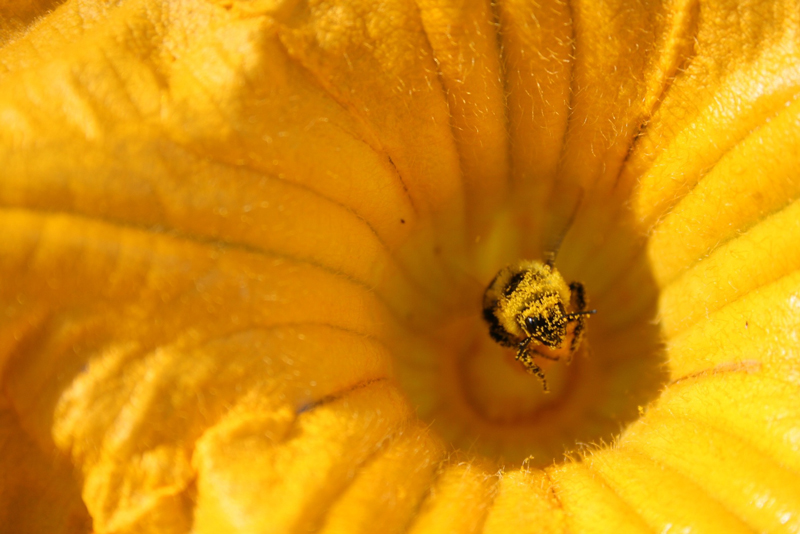North America has many delicious native fruits and vegetables, many of which have specialist pollinators they depend upon.
What do cherries, plums, serviceberries, black raspberries, blackberries, strawberries, and crab apples have in common (apart from making your mouth water)? What about blueberries, cranberries, teaberries, and kinnikinnick?
All are fruits of North American plants pollinated by native bees, flies, and other insects. Cherries and company are all in the rose family, while blueberries and their relatives are in the heath family. Both families contain many more native—and often—edible species.
While many crops grown in North America come from around the world, others originated there (like the blueberry) or in South America. For example, squash and pumpkin, tomato and potato, many of our favorite beans, and—best of all—chocolate, have South American origins. Cacao, the basis of chocolate, is in the mallow family, which includes marshmallow, okra, and hibiscus. Some of our crops, like strawberry and grape, are hybrids of plants from the Old World (Europe, Asia, Africa) and the New (North and South America).
There are many specialist bees associated with these plants. Specialist bees are those that eat pollen from one genus or family of plants—they may collect nectar from a much greater variety. There are many sunflower bees that eat pollen only from flowers in the aster family, though those flowers may be visited by many types of bees and other insects, both generalist and specialist. Plant-insect relationships are not always one-to-one.
Native, edible asters include sunchokes (aka Jerusalem artichokes) and sunflowers (grown for tuber, seed, or oil), as well as important medicinals like purple coneflowers (Echinacea species). Because asters have many flowers packed closely together and often have a relatively flat, open shape that makes nectar easy to reach, they also support many predatory and parasitoid flies, wasps, and beetles, whose shorter tongues mean they must feed from smaller flowers. These predators and parasites eat many crop pests.

Other specialist bees depend on pollen from flowers in the heath family. Blueberries and some of their relatives—like manzanitas—are frequently understory plants, and their specialist bees include the southeastern blueberry bee, Habropoda laboriosa; the Maine blueberry bee (a type of mason bee), Osmia atriventris; and a western mason bee, Osmia ribofloris.
Bumble bees, along with some of our native bees, can use their wing muscles to sonicate plants that require a special vibration to release pollen—called buzz-pollination. Flowers in the heath (blueberry, cranberry) and nightshade (tomato, groundcherry, pepper, eggplant, potato) families need sonication. You can view buzz-pollination in these video clips (compiled by the author before she worked for the Xerces Society).
Some of North America’s native bees migrated from South and Central America as indigenous peoples expanded squash and pumpkin production northwards. If you grow squash or pumpkin, squash bees (Peponapis and Xenoglossa species) are easy to recognize once you know to look for them. You can learn how to identify them here (this was also made by one of Xerces’ current staff members!).
Other native fruits include pawpaw in the custard-apple family, passionflower family, elderberry in the honeysuckle family, gooseberry and currant in the gooseberry family, pricklypear in the cactus family, and persimmon in the ebony family. While most wine grapes don’t need a pollinator, scuppernong and muscadine grapes do. The flowers of pawpaw and gooseberry bloom in early spring when conditions can be very cool and wet, a time when flies often act as very important pollinators. In Europe, syrphid (or flower) flies are nearly always included in pollinator surveys.
Watching a bumble bee or carpenter bee visit a passionflower blossom, it’s easy to see how they evolved together. Only these large bees are big enough to effectively pollinate the flower. In regions where passion fruit is grown commercially, growers provide wood for carpenter bee nesting. Passionflower vines also host a beautiful caterpillar, the larvae of the gulf fritillary butterfly.
While we enjoy the delicious edibles among our native plants, our native bees and other native fauna depend on our native flora for food and shelter. Plant native and help support a very special crowd.



